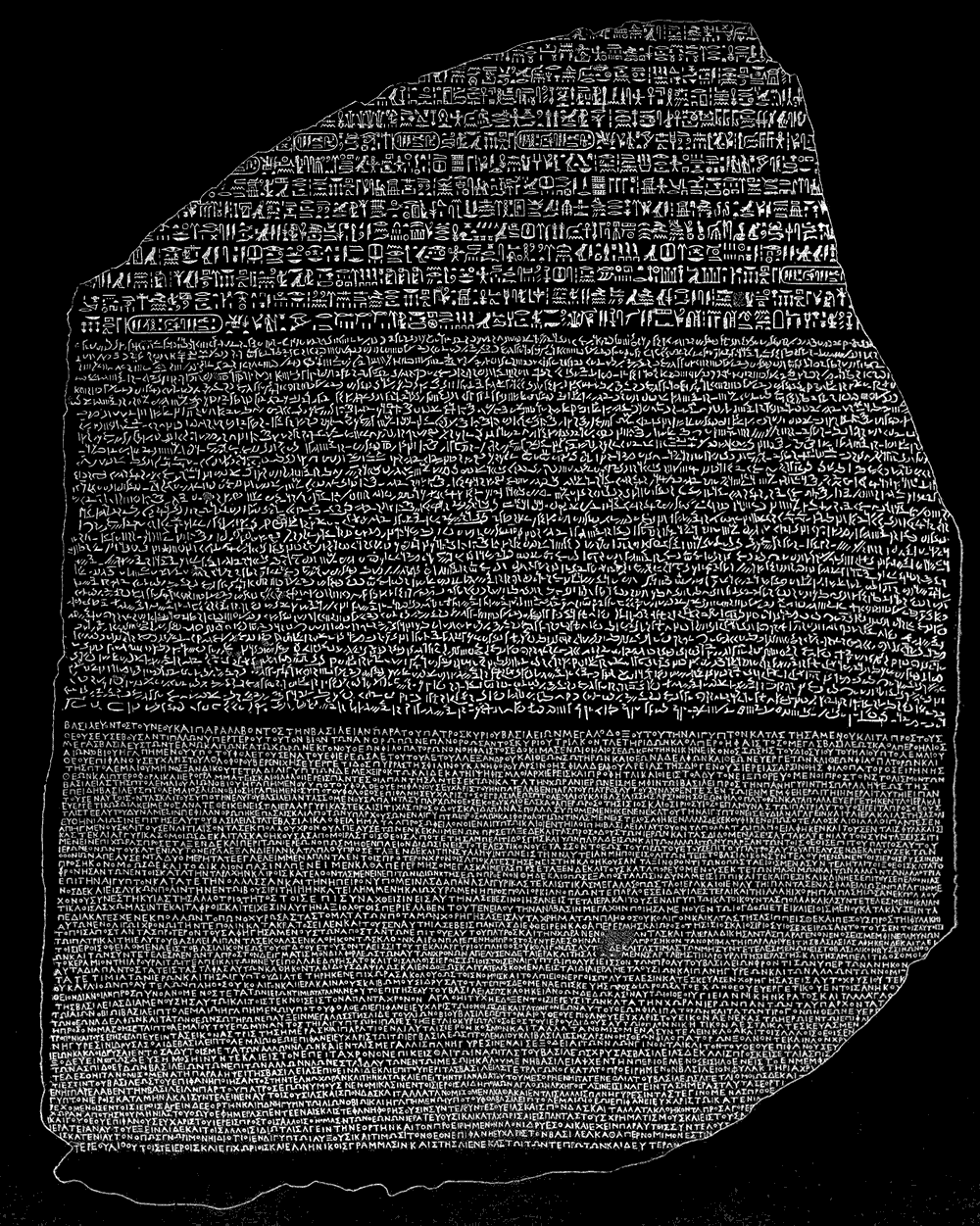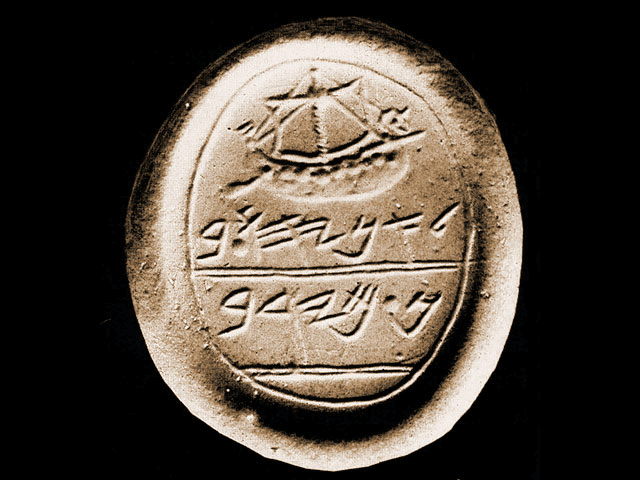The History
of Visual
Communication



The Alphabet
Abjads
An abjad is a writing system in which only consonants are represented, leaving vowel sounds to be inferred by the reader. This contrasts with alphabets, which provide graphemes for both consonants and vowels.
vvv
The first abjads emerged around 2000 BC in Ancient Egypt, as a representation of language developed by Semitic workers in Egypt. Most other alphabets in the world today either descended from this one discovery, or were directly inspired by its design, including the Phoenician alphabet and the Greek alphabet.
vvv
The first abjad to gain widespread usage was the Phoenician abjad. Unlike other contemporary scripts, such as cuneiform and Egyptian hieroglyphs, the Phoenician script consisted of only a few dozen symbols. This made the script easy to learn, and seafaring Phoenician merchants took the script throughout the then-known world. The Phoenician gave rise to a number of new writing systems, including the widely used Aramaic abjad and the Greek alphabet. The Greek alphabet evolved into the modern western alphabets, such as Latin and Cyrillic, while Aramaic became the ancestor of many modern abjads such as the Arabic and Hebrew alphabets.
The Rosetta Stone shows the co-existence of Hieroglyphics, Hieratic script and the Greek Alphabet in Egypt in the third century B.C.

The Proto-Canaanite alphabet, like its Egyptian prototype, only represented consonants, an abjad. From it can be traced nearly all the alphabets ever used, most of which descend from the younger Phoenician version of the script. The Aramaic alphabet, which evolved from the Phoenician in the 7th century BC as the official script of the Persian Empire, appears to be the ancestor of nearly all the modern alphabets of Asia.
Further reading and images:
http://www.thebritishmuseum.ac.uk/compass/ixbin/goto?id=OBJ67

The Phaistos Disc is a curious archaeological find, likely dating to the middle or late Minoan Bronze Age. Its purpose and meaning, and even its original geographical place of manufacture, remain disputed, making it one of the most famous mysteries of archaeology. No object directly comparable to the Phaistos Disc has been found. There is, however, a small number of comparable symbols known from other Cretan inscriptions, known summarily as Cretan hieroglyphs. This unique object is now on display at the archaeological museum of Herakleion in Crete, Greece.
There are a total of 241 tokens on the disc, comprising 45 unique signs. Many of these 45 signs represent easily identifiable every-day things. In addition to these, there is a small diagonal line that occurs underneath the final sign in a group a total of 18 times. The disc shows traces of corrections made by the scribe in several places. A great deal of speculation developed around the disc during the 20th century.
The Phaistos Disc captured the imagination of amateur archeologists. Many attempts have been made to decipher the code behind the disc's signs. Historically, almost anything has been proposed, including prayers, a narrative or an adventure story, a "psalterion", a call to arms, a board game, and a geometric theorem. Some of the more fanciful interpretations of its meaning are classic examples of pseudoarchaeology.
While enthusiasts still believe the mystery can be solved, scholarly attempts at decipherment are thought to be unlikely to succeed unless more examples of the signs turn up somewhere, as it is generally thought that there isn't enough context available for meaningful analysis. Any decipherment without external confirmation, such as successful comparison to other inscriptions, is unlikely to be accepted as conclusive.
Further reading and images
http://www.crystalinks.com/phaistosdisc.html



The Phoenicians
The Phoenician alphabet seamlessly continues the Proto-Canaanite alphabet, by convention called Phoenician from the mid 11th century. The Phoenicians are the descendants of the Bronze Age Canaanites who, protected by the Lebanon mountains and the sea, did not succumb to the Israelites or the 'Sea Peoples'. When they first appear in western historiography, in the eighth and seventh century BCE, the Phoenicians already possess scores of colonies all around the Mediterranean, and have extensive trade networks, extending as far as the Atlantic coast of Africa and the Black Sea, from which they challenged the Greeks, and later the Romans, for supremacy of the seas. According to Biblical accounts, already at an earlier period, the tenth century BCE, their artisans and artists were unparalleled, and they were sponsoring, together with king Solomon, ambitious naval undertakings. The Phoenician alphabet was based on the principle that one sign represents one spoken sound.
Besides Aramaic, the Phoenician alphabet gave rise to the Greek and Berber alphabets. Whereas separate letters for vowels would have actually hindered the legibility of Egyptian, Berber, or Semitic, their absence was problematic for Greek, which had a very different morphological structure. However, there was a simple solution. All of the names of the letters of the Phoenician alphabet started with consonants, and these consonants were what the letters represented. However, several of them were rather soft and unpronounceable by the Greeks, and thus several letter names came to be pronounced with initial vowels. By the acrophonic principle that was the basis of the system, the letters now stood for those vowels. For example, the Greeks had no glottal stop or h, so the Phoenician letter ’alep' became the Greek 'alpha' and e (later renamed epsilon). As this fortunate development only provided for six of the twelve Greek vowels, the Greeks eventually created digraphs and other modifications, such as ei, ou, and o (which became omega), or in some cases simply ignored the deficiency, as in long a, i, u.
Further reading and images
http://phoenicia.org/
http://www.cedarland.org/phoenicia.html
http://www.cedarland.org/ships.html
The Greek Alphabet
The Greek alphabet is the source for all the modern scripts of Europe. The History of the Greek alphabet starts with the adoption of Phoenician letterforms and continues to the present day. The Phoenician alphabet was strictly speaking an abjad in other words it represented only consonants. This arrangement is much less suitable for Greek than for Semitic languages and several of the Phoenician consonants, representing sounds or distinctions not present in Greek, were adapted to represent vowels; consequently the Greek alphabet can be considered to be the world's first true alphabet.


"Boustrophedon" (as the ox plows): Lines go from left to right and from right to left.



The alphabet of the early western Greek dialects, where the letter "eta" remained an "h", gave rise to the Old Italic and Roman alphabets. In the eastern Greek dialects, which did not have an "h", "eta" stood for a vowel, and remains a vowel in modern Greek and all other alphabets derived from the eastern variants: Glagolitic, Cyrillic, Armenian, Gothic (which used both Greek and Roman letters), and perhaps Georgian.
Further reading and images
http://www.arwhead.com/Greeks/
http://www.museum.upenn.edu/Greek_World/Index.html
http://members.aol.com/Donnclass/Greeklife.html
http://www.mnsu.edu/emuseum/prehistory/aegean/
http://www.mythweb.com/
http://en.wikipedia.org/wiki/Greek_mythology




The Romans
Several hundred years later, the Romans used the Greek alphabet as the basis for the uppercase alphabet that we know today. They refined the art of handwriting, fashioning several distinctive styles of lettering which they used for different purposes. They developed a rigid, formal script for important manuscripts and official documents and a quicker, more informal style for letters and routine types of writing. However the Romans made further important contributions to type design: In the Roman alphabet, serif's originated with the carving of words into stone in ancient Italy: Roman stonemasons started adding little hooks to the tips of letters to prevent the chisel from slipping, which turned out to be the very aesthetic as well as legibility increasing addition to type that we use to this day.




The Romans invented Serifs for ease of chiseling letters into stone.

The alphabet used by the Romans consisted only of capital (upper case or majuscule) letters. The lower case (minuscule) letters developed in the Middle Ages from cursive writing, first as the uncial script, and later as minuscule script. The old Roman letters were retained for formal inscriptions and for emphasis in written documents. The languages that use the Latin alphabet generally use capital letters to begin paragraphs and sentences and for proper nouns.

Yet another Roman innovation is the institution of the baseline: In typography and penmanship, the baseline is the line upon which most letters "sit" and under which descenders extend. By these additions Romans ensured that type, in opposition to the higgeldy piggedly writing of the Greeks, was perfectly aligned in rows, thus greatly contributing to type aesthetics.

The Codex
By A.D. 100, the Romans had developed a flourishing book industry and, as Roman handwriting continued to evolve, lower case letters and rough forms of punctuation were gradually added. Yet another Roman innovation was the invention of the Codex: A codex (Latin for block of wood, book; plural codices) is a handwritten book, in general, one produced from Late Antiquity through the Middle Ages. The codex was a vast improvement upon the scroll, which it gradually replaced as the written medium. In Western culture the codex gradually replaced the scroll. From the fourth century, when the codex gained wide acceptance, to the Carolingian Renaissance in the eighth century, many works that were not converted from scroll to codex were lost to posterity. The codex was an improvement over the scroll in several ways. It could be opened flat at any page, allowing easier reading; the pages could be written on both recto and verso; and the codex, protected within its durable covers, was more compact and easier to transport. The codex also made it easier to organize documents in a library because it had a stable spine on which the title of the book could be written. The spine could be used for the incipit, before the concept of a proper title was developed, during medieval times. Although most early codices were made of papyrus, papyrus was fragile and supplies from Egypt, the only place where papyrus grew, became scanty; the more durable parchment and vellum gained favor, despite the cost. From the point of view of Graphic Design the codex completely revolutionised the field in that codices brought about the gridded page layout system, which we still use today.
Further reading and images
http://www.exovedate.com/ancient_timeline_one.html
http://members.aol.com/Donnclass/Romelife.html
http://www.historylink101.com/ancient_rome.htm
http://www.dl.ket.org/latin1/things/romanlife/ancientp15.htm
http://www.geocities.com/Athens/Delphi/8991/roman.html
http://en.wikipedia.org/wiki/Roman_mythology
References
http://en.wikipedia.org/wiki/History_of_the_alphabet
http://en.wikipedia.org/wiki/Phaistos_disk
http://graphicdesign.spokanefalls.edu/tutorials/process/type_basics/history.htm
http://en.wikipedia.org/wiki/Phoenicians
http://en.wikipedia.org/wiki/Greek_alphabet
http://en.wikipedia.org/wiki/Roman_alphabet
http://en.wikipedia.org/wiki/Codex